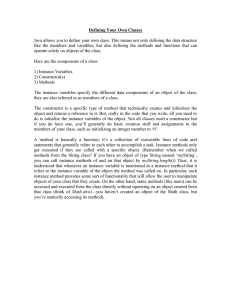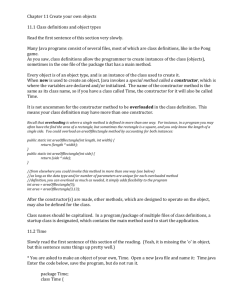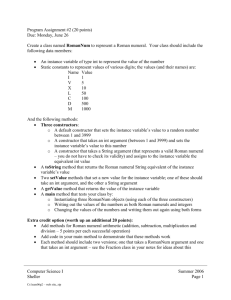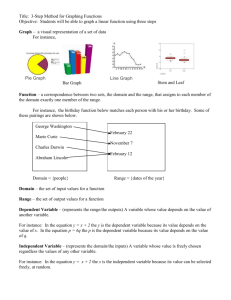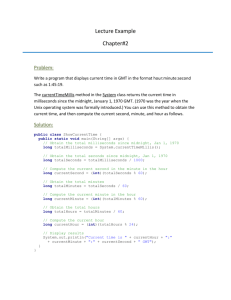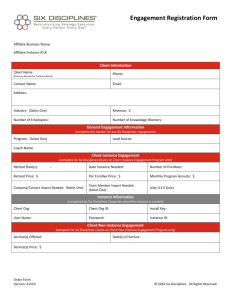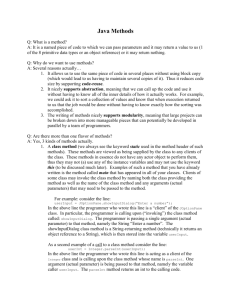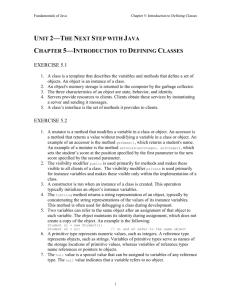Note
advertisement
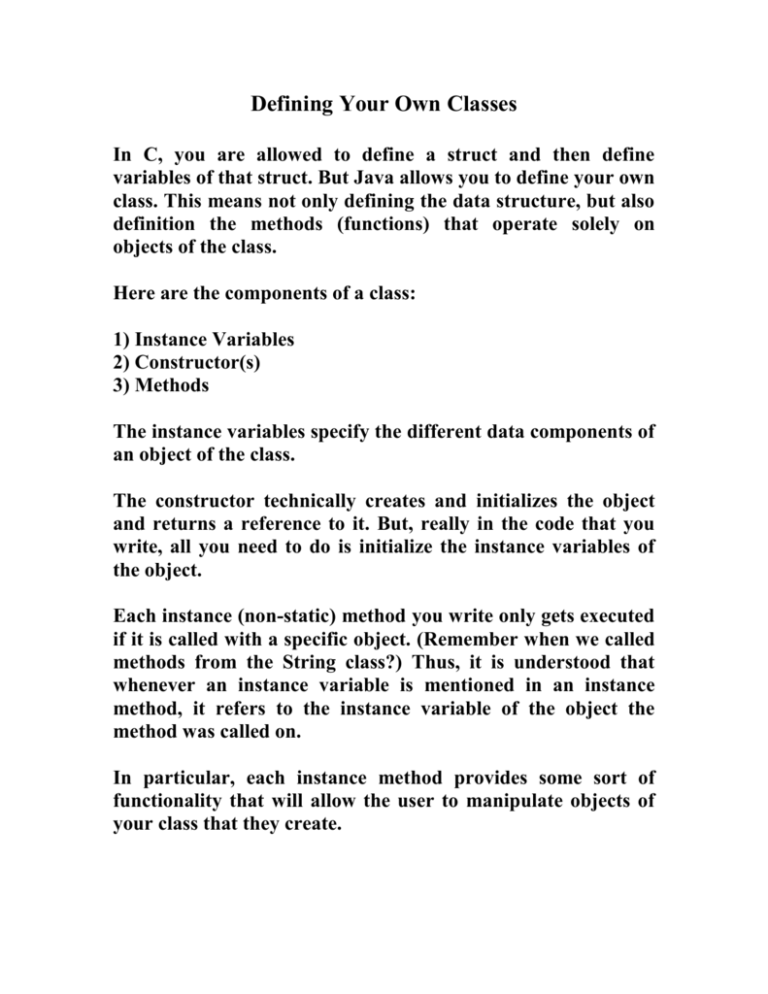
Defining Your Own Classes
In C, you are allowed to define a struct and then define
variables of that struct. But Java allows you to define your own
class. This means not only defining the data structure, but also
definition the methods (functions) that operate solely on
objects of the class.
Here are the components of a class:
1) Instance Variables
2) Constructor(s)
3) Methods
The instance variables specify the different data components of
an object of the class.
The constructor technically creates and initializes the object
and returns a reference to it. But, really in the code that you
write, all you need to do is initialize the instance variables of
the object.
Each instance (non-static) method you write only gets executed
if it is called with a specific object. (Remember when we called
methods from the String class?) Thus, it is understood that
whenever an instance variable is mentioned in an instance
method, it refers to the instance variable of the object the
method was called on.
In particular, each instance method provides some sort of
functionality that will allow the user to manipulate objects of
your class that they create.
Types of Variables in an instance method:
1) Instance Variables
2) Formal Parameters
3) Local Variables
Each of these is a different kind of variable. Even though you
are allowed to, do NOT name variables of these different
"types" the same name. It will cause confusion, I guarantee it.
(Java has rules that specify which of the variables you are
referring to if the name is ambiguous.)
As already mentioned, instance variables belong to the object
the method was called on. The formal parameters serve the
same purpose they do in all methods - they are the input the
method needs to complete its task. Local variables also serve
the same purpose in instance methods as all methods.
(Note: This handout is included on the class website.)
Here is a portion of the Time class handout:
public class Time {
private int hours;
private int minutes;
public Time(int m) {
hours = m/60;
minutes = m%60;
}
private int totalminutes() {
return 60*hours+minutes;
}
public boolean equals(Time time2) {
if (this.totalminutes() == time2.totalminutes())
return true;
else
return false;
}
public Time addtime(Time time2) {
int min = totalminutes() + time2.totalminutes();
Time temp = new Time(min);
return temp;
}
public String toString() {
return (hours+" hours and "+minutes+" minutes");
}
}
The two instance variables that comprise a Time object are two
integers: hours and minutes.
You'll notice that the constructor's job is simply to initialize
the object. Generally the parameters of a constructor are used
to initialize (set the values of) the instance variables.
(Remember how this works when it is called...the constructor
allocates space for the object and returns a reference to that
newly created object. However, these details are hid from you
even when you write the constructor! So, all you have to do is
initialize the instance variables based on the formal parameters
when you write the constructor.)
What NOT to do in a constructor:
1) Mistake the left&right hand sides of assignment statements.
2) Create local variables with the names of either the formal
parameters OR instance variables.
A Note of Visibility Modifiers
For now, the only visibility modifiers we will use are public
and private. These indicate where an instance variable or
method may be accessed. In particular if something is private,
it may only be referred to within the class. If something is
public, it can be used anywhere.
The general rule of thumb is that all instance variables are
made private. The reason is that classes allow us to create
abstract data types. This means that a person can USE an
object without knowing HOW it is stored or HOW the methods
in the class work.
If other programmers are given access to the instance variables
of the objects they create, then they have the power to
manipulate the object any way they want. BUT, in order to use
this power effectively, the user must understand the details of
HOW the object works. THIS DEFEATS THE WHOLE
PURPOSE OF FORMING CLASSES IN THE FIRST
PLACE!!!
Generally, most methods are made public so that others can
use them. However, it is not inconceivable to design a private
method. Consider the totalminutes method in the Time class
above. There is no need to allow someone USING the class to
call this method. Rather, I have simply written it so that I can
carry out other methods (such as equals and addtime) with a
more efficient design. Since the purpose of the method is
internal to making other methods in the class, I have chosen to
make it private.
Use of this
You'll notice that inside of the equals() method I have used an
object called this. This can ONLY be used inside of an instance
method of a class. In particular, this refers to the object the
method was called on. I wrote it in this method to be explicit. If
you look at the line:
if (this.totalminutes() == time2.totalminutes())
you'll see that the boolean expression is comparing the total
number of minutes in the object the method is called on WITH
the total number of minutes in the object time2.
Although I have been explicit here, it was not necessary to do
so. Consider this line from the addtime method:
int min = totalminutes() + time2.totalminutes();
Whenever an instance method call is made without the object
specified inside of another instance method, the call is
AUTOMATICALLY made on the object the original method
was called on, (which is this.)
There are some cases where it is necessary to use this, but
usually, one can get away without using it. Standard
convention is to do so - my guess is simply to save typing.
Consider the constructor rewritten with these two assignment
statements:
this.hours = m/60;
this.minutes = m%60;
This (no pun intended) seems like a little overkill...
addtime Method
In this method I take in a Time object and return a Time
object as well. (Notice the similarity of this prototype to that of
several methods in the String class, such as concat.)
Here is the code again:
public Time addtime(Time time2) {
int min = totalminutes() + time2.totalminutes();
Time temp = new Time(min);
return temp;
}
In order to complete the task, I first need to compute the sum
of the minutes in both objects(this and time2). I do this in the
first line using the totalminutes method.
Next, I need to create a Time object using the computed
information. This can be done with a call to the constructor.
Finally, I need to return a reference to the newly created
object. (This is temp.)
As we can see here, what all the String methods that return a
String must do is make a call to a String constructor inside the
method and return a reference to that object that was created.
Alternate version of addtime
If we wanted addtime to automatically change the current
object to the sum of the two times instead of returning a new
object, we could write it as follows:
public void addtime(Time time2) {
int min = totalminutes() + time2.totalminutes();
hours = min/60;
minutes = min%60;
}
Once again, we must calculate the sum of the total number of
minutes in the current object and time2. But, after this
calculation, rather than creating a new object, what we want to
do is change the current object to reflect this time. We can do
this by resetting both the hours and minutes components of the
current object as shown above.
Thus, when this method is called (as opposed to the previous
one), the object the method is called upon changes to store the
sum of its "old" time and time2's time.
